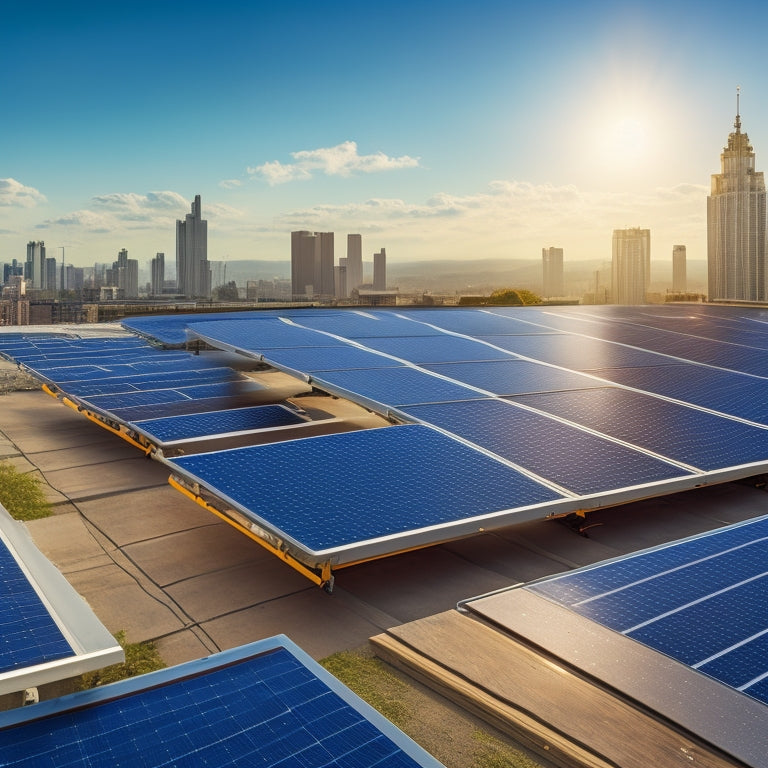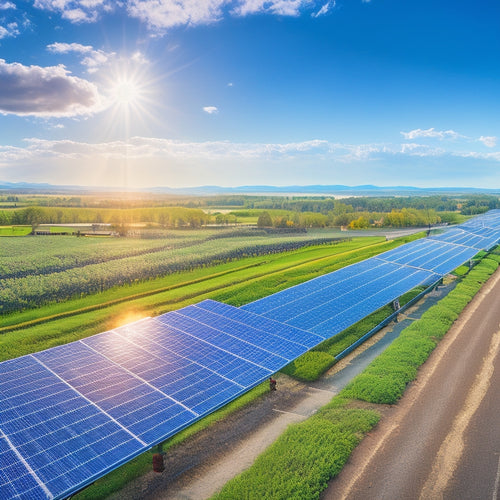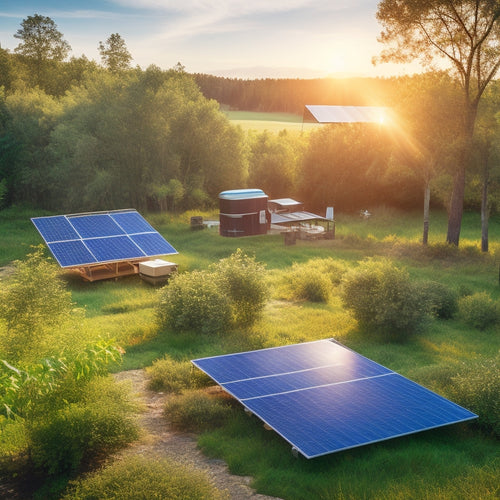
5 Best Tips for Solar Panel Installation
Share
You'll want to start by evaluating your roof's readiness, conducting a thorough analysis of the material, age, and condition to guarantee it can support the solar panels. Next, choose the right panel type for your needs, considering factors like efficiency ratings and budget. Optimize energy output by adjusting the solar angle, cleaning the panels regularly, and confirming they face directly at the sun. Prioritize safety during installation by adhering to electrical codes and regulations, and conducting a thorough risk evaluation. Finally, develop a maintenance schedule to keep your system running at its best. Now that you've got the basics covered, you're ready to plunge deeper into the specifics that will make your solar panel installation a success.
Key Takeaways
- Ensure a roof readiness assessment to identify potential issues and guarantee structural support for solar panels.
- Select the right solar panel type, considering factors like efficiency, price, and technology advancements, such as bifacial panels.
- Optimize solar panel angle and orientation based on geographic location and seasonal changes to maximize energy output.
- Prioritize safety gear, electrical codes, and risk assessments during installation to minimize hazards and ensure a secure setup.
- Implement a regular maintenance schedule, including quarterly inspections and annual professional maintenance, to ensure optimal performance and longevity.
Assessing Your Roof's Readiness
Before installing solar panels, your roof becomes a crucial factor in the equation.
You'll need to conduct a thorough roof material analysis to confirm it can support the weight and durability of the solar panels. Take into account the age, condition, and material of your roof - asphalt shingles, metal, or clay tiles, for instance. Each material has its own set of requirements and limitations.
When evaluating solar panels, it's important to take into account efficiency ratings above 20% to maximize energy generation per sunlight hour.
Additionally, you'll need to take into account shading considerations, such as nearby trees, buildings, or skylights, which can impact the panel's energy output.
A professional assessment will help identify potential issues and provide recommendations for any necessary repairs or upgrades before installation.
Choosing the Right Solar Panel
With your roof's readiness confirmed, it's time to focus on selecting the ideal solar panel for your energy needs.
You'll encounter various panel types, each with its strengths and weaknesses. Monocrystalline panels offer high efficiency ratings, but come at a higher cost. Polycrystalline panels provide a balance between efficiency and affordability. Thin-film panels are budget-friendly but less efficient.
When evaluating panel types, consider the advancements in solar technology that can increase energy output, such as bifacial solar panels. Additionally, the International Energy Agency predicts solar power to become the largest electricity source by mid-century, driven by decreasing costs and efficiency improvements.
Consider your energy requirements and budget to determine the best panel type for you. Efficiency ratings, measured in percentages, indicate how much sunlight is converted into electricity. Look for panels with high efficiency ratings (above 20%) for peak energy production.
Maximizing Energy Output Potential
Ideally angled and strategically placed, your solar panels can capture the sun's energy to its fullest potential.
To maximize energy output, you need to optimize the solar angle, which varies depending on your location and time of year. In the northern hemisphere, a tilt of 30-40 degrees is ideal, while in the southern hemisphere, a tilt of 20-30 degrees is best.
Regular cleaning with water-efficient methods can also improve energy output by up to 25%, so it's vital to incorporate this into your maintenance routine. Confirm your panels face directly at the sun, with minimal shading from trees, buildings, or other obstructions.
Energy efficiency is also significant, so choose high-efficiency panels that can convert sunlight into electricity at a higher rate.
Ensuring Safe Installation Practices
As you prepare to install your solar panels, guaranteeing safe installation practices is essential to avoid accidents, injuries, and even fatalities.
You must prioritize safety above all else to protect yourself, your team, and anyone nearby. To achieve this, make certain to:
- Wear proper safety gear, including hard hats, gloves, and safety glasses, to prevent physical harm from falling objects or electrical shock.
This is especially critical when working with high-voltage systems, such as those found in off-grid solar power systems, which require careful handling and installation.
- Follow electrical codes and regulations to guarantee the installation meets the required standards and minimizes the risk of electrical hazards.
It's important to take into account factors like grid connection and energy management to prevent any potential electrical hazards.
- Conduct a thorough risk assessment before starting the installation to identify potential hazards and take necessary precautions.
Post-Installation Maintenance Essentials
After successfully installing your solar panel system, you'll want to guarantee it operates at peak performance and efficiency over its lifespan. Regular maintenance is vital to secure ideal energy production. Implement cleaning techniques to remove dirt and debris that can reduce energy output. Inspect your system regularly for signs of wear and tear, and address any issues promptly. Performance monitoring is also fundamental to identify potential problems early on.
| Maintenance Task | Frequency |
|---|---|
| Clean solar panels | Every 6 months |
| Inspect system components | Quarterly |
| Review performance data | Monthly |
| Schedule professional maintenance | Annually |
Frequently Asked Questions
Can I Install Solar Panels on a Rented Property?
A million questions are running through your mind, but first, let's tackle the big one: can you install solar panels on a rented property? The short answer is, it's possible, but you'll need to maneuver through rented property regulations and secure your landlord's permissions before moving forward.
How Do I Handle Solar Panel Warranties and Repairs?
You'll want to carefully review your solar panel warranty to understand warranty coverage and potential repair costs, ensuring you're prepared for any issues that may arise and can minimize downtime and expenses.
Are Solar Panels Fragile and Prone to Breakage?
You'll be relieved to know that solar panels are designed to be highly durable and impact-resistant, with most manufacturers testing them to withstand hail, high winds, and extreme weather conditions, ensuring they can withstand the elements without breaking.
Can I Install Solar Panels Myself to Save Money?
You're considering a DIY solar installation to reap cost savings, but it's vital to weigh the risks: improper installation can void warranties, compromise efficiency, and even pose safety hazards, so it's important to carefully assess your knowledge before taking on the project.
Do Solar Panels Work During Power Outages?
You're wondering if solar panels work during power outages? They won't, unless you have a battery backup system, which guarantees energy independence by storing excess energy for later use, maintaining your solar panel functionality.
Related Posts
-

Solar Phone Chargers for Camping Essentials
Solar phone chargers are must-haves for your camping essentials, allowing you to stay connected while enjoying nature...
-

Applications of Photovoltaic Systems
Photovoltaic systems are versatile, converting sunlight into electricity for various applications. You can use them i...
-

Top Off Grid Solar Batteries for Renewable Energy
When seeking top off-grid solar batteries for renewable energy, consider options with advanced battery chemistry, suc...


